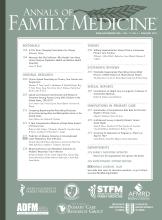Abstract
PURPOSE Prior studies have evaluated factors predictive of inappropriate antibiotic prescription for upper respiratory tract infections (URIs). Community factors, however, have not been examined. The aim of this study was to evaluate the roles of patient, clinician, and community factors in predicting appropriate management of URIs in children.
METHODS We used a novel database exchange, linking electronic health record data with community statistics, to identify all patients aged 3 months to 18 years in whom URI was diagnosed in the period from 2007 to 2012. We followed the Healthcare Effectiveness Data and Information Set (HEDIS) quality measurement titled “Appropriate treatment for children with upper respiratory infection” to determine the rate of appropriate management of URIs. We then stratified data across individual and community characteristics and used multiple logistic regression modeling to identify variables that independently predicted antibiotic prescription.
RESULTS Of 20,581 patients, the overall rate for appropriate management for URI was 93.5%. Family medicine clinicians (AOR = 1.5; 95% CI 1.31, 1.71; reference = pediatric clinicians), urgent care clinicians (AOR = 2.23; 95% CI 1.93, 2.57; reference = pediatric clinicians), patients aged 12 to 18 years (AOR = 1.44; 95% CI 1.25, 1.67; reference = age 3 months to 4 years), and patients of white race/ ethnicity (AOR = 1.83; 95% CI 1.41, 2.37; reference = black non-Hispanic) were independently predictive of antibiotic prescription. No community factors were independently predictive of antibiotic prescription.
CONCLUSIONS Results correlate with prior studies in which non-pediatric clinicians and white race/ethnicity were predictive of antibiotic prescription, while association with older patient age has not been previously reported. Findings illustrate the promise of linking electronic health records with community data to evaluate health care disparities.
- information management
- informatics
- electronic health records
- public health
- health care delivery
- health services research
- social conditions
- infants
- children
- adolescents
- Received for publication March 27, 2015.
- Revision received July 15, 2015.
- Accepted for publication August 3, 2015.
- © 2015 Annals of Family Medicine, Inc.







